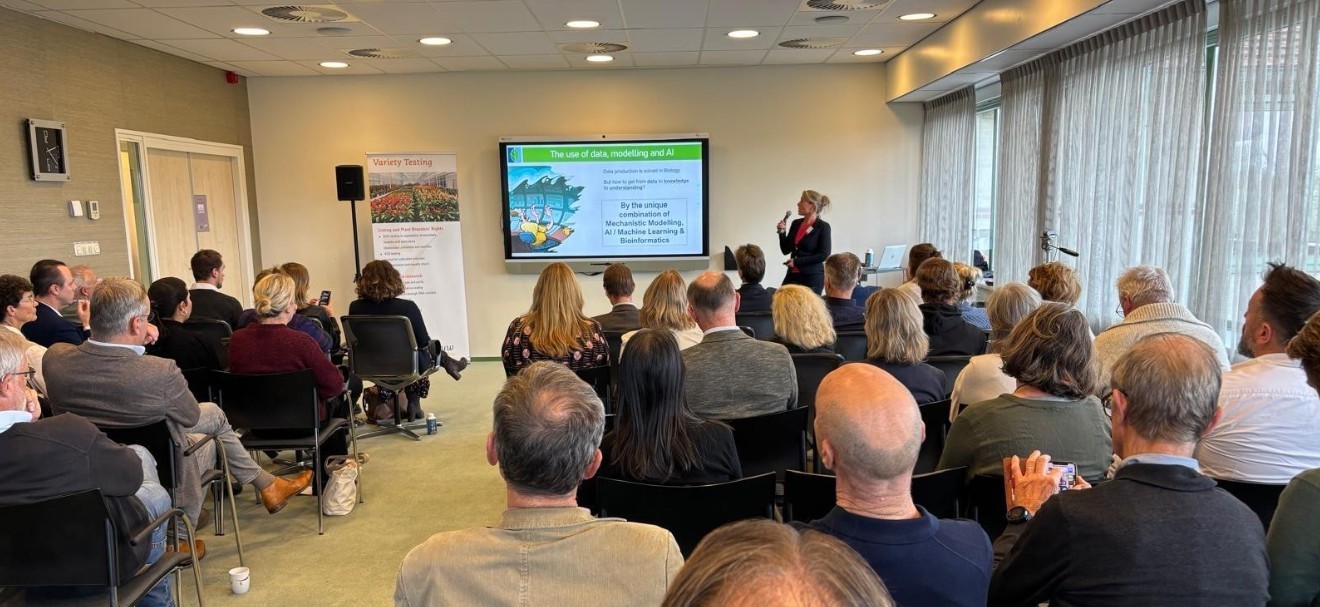To divide is to multiply: how can DNA accelerate or improve DUS testing and breeding processes?
Publicationdate: 6 november 2025
On Thursday, October 30th, a symposium on the application of DNA information in plant breeding and DUS testing took place at Naktuinbouw. Speakers with important participation in the field shared their vision for the future of variety research, identification and breeding using DNA techniques. The central question was: how to increase collaboration and sharing of DNA knowledge - what is needed for this?

Substantive contributions and current insights
Participants received four presentations on key topics:
- Hedwich Teunissen (Managing Director – CropXR) CropXR (a public-private partnership) has set themselves the goal of developing resistant crops through data-driven designs (AI, modelling and machine learning) by 2033. A key success factor for achieving this goal is the willingness to collaborate, share knowledge and data. Several commercial partners have joined and are uniting within CropXR.
- Tosca Ferber (Chief Technology Officer - Dümmen Orange) gave attendees a glimpse behind the scenes of Dümmen Orange's breeding strategy, focusing on the emergence and application of DNA information for a growing group of crops. Dümmen Orange recognizes the importance of sharing and collaborating data, as they have established several systems to facilitate this.
- Cécile Collonnier (Technical expert Research & Innovation - CPVO) discussed the legal aspects of DNA use and DUS research within European regulations.
- Raoul Haegens (Head of Identification and Variety Testing - Naktuinbouw) shared Naktuinbouw's vision on the use of DNA techniques in DUS research and the importance of data sharing for the sector.
Discussion
The afternoon ended with a group discussion, in which the audience explored the question: What do you (as an organization) need to collaborate and share DNA knowledge? Some of the shared thoughts:
Why collaborate?
- There should be a financial benefit to collaboration, for example lower costs for data providers.
- If the registration process is faster through collaboration, that is a good reason to re-evaluate and open the discussion to assist Naktuinbouw with their DNA developments.
- Through collaboration we can better align DUS testing with developments in technology and among breeders.
- Data-driven breeding will eventually lead to Plant Breeders' Rights research using input from datasets.
- (Inter)national data exchange equals to less efforts duplication.
Preconditions for working together in confidence
- The common objective must be clear. The framework must be transparent and clear rules are needed for “data security”.
- Legal agreements between parties on the use of data are necessary (separation between public and private use of datasets).
- Determine for which crops support is important.
- Educate the sector on how DNA is used in DUS testing and how breeders can benefit by sharing knowledge.
- International Validation of the System by CPVO. This must be part of plant variety protection.
- Trust is essential and companies must be open to collaborating; otherwise, it's pointless.
How can we shape the collaboration?
- By setting up a working group with all partners from the sector.
- Time and good communication.
Innovation as a sector in the Netherlands
- Open source approach so that large and small breeders have the same tools available
Infringement
- The use of CRISPR-Cas techniques is expected to result in more essentially derived varieties (EDVs). Incorporating DNA-based methods into the plant variety rights system can help accurately assess such cases and provide more effective support in infringement disputes.
This Knowledge symposium demonstrated that most participants recognize the opportunities presented by collaboration and knowledge sharing. Commercial interests and legal considerations often lead to reluctance. Naktuinbouw is eager to explore the possibilities and preconditions for this with various parties. After all, the future of our sector is a shared responsibility.
